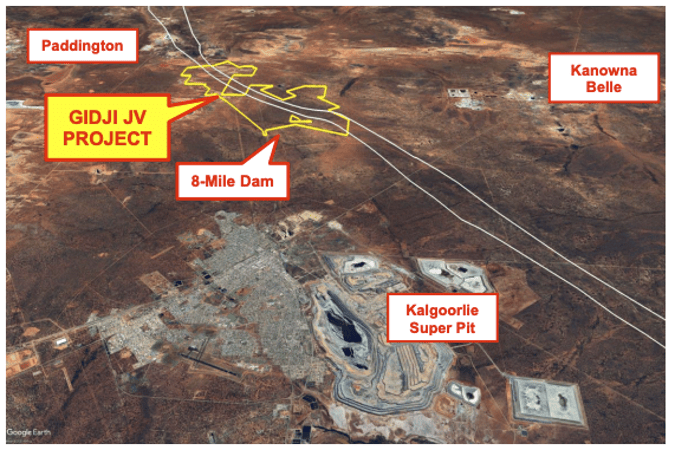The drilling program, which also tested two other IP targets across the Gidji JV, is nearing completion. Pic: Getty Images
- Miramar strikes gold in first drill hole at 8 Mile target
- The target is adjacent to Northern Star’s 8 Mile gold deposit
- Further RC and diamond drilling will be planned once all assays are received
Special Report: The first drill hole at Miramar’s 8 Mile target within the wider Gidji JV project about 15km north of Kalgoorlie has intersected high-grade gold and ended in mineralisation.
Miramar’s (ASX:M2R) 8 Mile target is adjacent to Northern Star’s (ASX:NST) 8-Mile Dam gold deposit, which according to the most recent publicly available data, contains an estimated 7Mt at 1.4g/t gold for 313,977oz.
A limited number of fast-tracked results from the first RC hole, GJRC029, show a wide zone of mineralisation with a similar tenor to 8-Mile Dam returning 18m at 0.94g/t Au from 480m, including 1m at 6.04g/t.
The remaining assay results are expected within the next two to three weeks.
Extended strike for more than 100m
M2R executive chairman Allan Kelly said the company was excited to see gold mineralisation continuing onto Miramar’s ground for a significant distance.
“This is the first time we have discovered significant gold mineralisation on our side of the fence, even though the drill hole didn’t end up exactly where we planned it to,” he said.
“The flip side of this is that we have extended the strike of gold mineralisation for over 100m on to our tenements.
“We’ve also demonstrated a relationship between the IP anomalism and gold mineralisation, which makes the other IP anomalies we have outlined at Gidji even more prospective,” he said.

Drilling details
Hole GJRC029 was designed to test an Induced Polarisation (IP) anomaly on the tenement boundary interpreted to represent the sulphide-rich gold mineralisation seen at neighbouring 8-Mile Dam.
The hole deviated significantly from the planned azimuth and, as a result, by the time it was terminated at the target depth of 504m, the drill trace ended up about 75m north of the tenement boundary.
Despite this, the hole intersected a thick section of the steep westerly dipping and highly altered 8 Mile mafic unit with widespread sulphide mineralisation, including disseminated magnetite and coarse-grained arsenopyrite, pyrrhotite and chalcopyrite, similar to Northern Star’s 8-Mile Dam deposit.
Based on visual logging of RC drill chips, handheld portable XRF results and magnetic susceptibility measurements, samples from the bottom 56m of the hole were sent for priority analysis by fire assay at Bureau Veritas in Kalgoorlie.
Results from these initial samples confirm the relationship between the gold mineralisation and sulphides, and a relationship between the best gold mineralisation and coincident magnetic anomalism and elevated arsenic as measured by handheld portable XRF.
What’s happening next?
The initial RC drilling program, which also tested two other IP targets, is nearing completion and results will be reported once received and compiled.
Once all assays are received, Miramar will plan further RC and/or diamond drill holes including to test the dip and strike extent of the mineralisation intersected in GJRC029.
The WA Department of Mines, Petroleum and Exploration (DMPE) has extended the permit for the main Gidji JV tenement, E26/214, for a further five years, and it will now expire in March 2030.
This article was developed in collaboration with Miramar Resources, a Stockhead advertiser at the time of publishing.
This article does not constitute financial product advice. You should consider obtaining independent advice before making any financial decisions.



